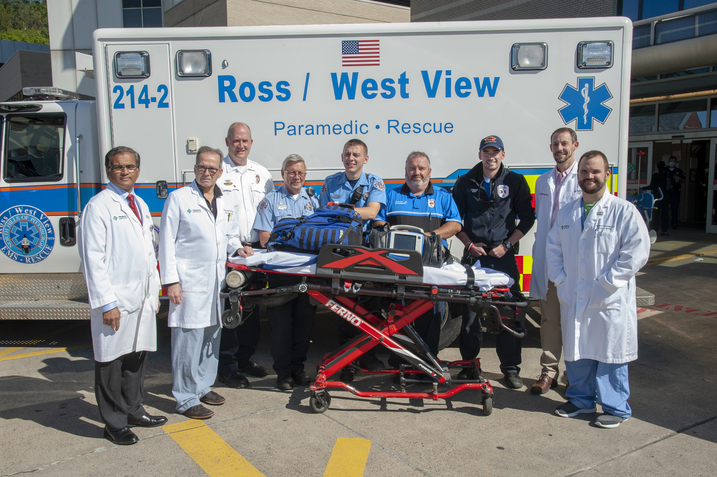Allegheny Health Network’s media relations team is dedicated to providing reporters and other members of the news media with the assistance they need.

Allegheny Health Network Launches EMS Field Activation of ECMO Life Support for Some Patients in Out-of-Hospital Cardiac Arrest
PITTSBURGH, PA. – More than 400,000 people in the United States experience an out-of-hospital cardiac arrest every year. Unlike a heart attack, which gives warning symptoms such as chest pain, people suffering a cardiac arrest may feel fine up until the moment their hearts stop beating.
From that moment on, every second is critical. According to the American Heart Association and American Stroke Association, a quick application of CPR and defibrillation can double the patient's chance of survival. Yet even with heroic efforts by Emergency Medical Service (EMS) personnel or bystanders, the survival rate for out-of-hospital cardiac arrest is only about 10 percent.
Allegheny Health Network (AHN) 's Allegheny General Hospital is now one of just a few centers in western Pennsylvania providing some cardiac arrest patients with EMS field activation of ECMO (extracorporeal membrane oxygenation). ECMO, a life support method in which a pump keeps blood flowing and keeps the body oxygenated while the heart is stopped, has traditionally been used only in an inpatient setting, but research indicates it can be effectively used in an emergency setting to improve outcomes in out-of-hospital cardiac arrest.
"Improving survival rates for out-of-hospital cardiac arrest, and retaining neurologic function for those who do survive, has been a formidable challenge for those of us who treat heart disease," said Stephen Bailey, MD, cardiothoracic surgeon and co-chair of AHN Cardiovascular Institute. "We are delighted to begin offering EMS-activated ECMO to patients who are transported to the AGH Cardiac Catheterization Laboratory via emergency department in cardiac arrest, as studies have shown survival rates from 25 percent to 43 percent for these patients, with better neurologic outcomes."
"The launch of EMS-activated ECMO at AGH for out-of-hospital cardiac arrest patients could not have happened without strong partnerships with a shared dedication to innovative care," said Thomas Campbell, MD, Chair, AHN Emergency Medicine. "EMS-activated ECMO is a complex process requiring an integrated team of community EMS partners, emergency medicine physicians, Interventional cardiologists, critical care specialists, and a follow-up care team, all of whom work together in a highly coordinated way to give our cardiac arrest patients the best chance of returning to their regular lives."
In addition to Drs. Bailey and Campbell, the launch of EMS-activated ECMO was led by Subbarao Elapavaluru, MD, Medical Director of the AGH ECMO Program; Michael Collins, MD, Surgical Director of the AGH ECMO Program, and Emergency Physicians Philip Nawrocki, MD, Matthew Poremba, DO, and Chadd Nesbit, MD, Ph.D., Interventional Cardiologists Mithun Chakravarthy, MD, and David Lasorda, DO.
The EMS-activated ECMO process starts when EMS providers arrive at the scene of a cardiac arrest and begin administering mechanical CPR (LUCAS deviceÒ) and delivering electrical shocks to the heart with a defibrillator, keeping the heart beating and blood flowing to the patient's brain. Once EMS providers determine the patient is a good candidate for ECMO, they alert the emergency department at AGH.
There, an Immediately cardiac catheterization laboratory (CCL) team is activated, including a team of Board-Certified emergency physicians, Cardiothoracic surgeons, Perfusionist, Cardiac Intensivists, nurses, and support personnel. The patient is transported directly to the cardiac catheterization laboratory, where interventional cardiologists will place the patient on an ECMO while the mechanical CPR is in progress(ECPR-Extracorporeal Cardiopulmonary Resuscitation)
Once the ECMO is connected to the patient, through plastic tubes called a cannula placed in large veins and arteries, and heartbeat and blood flow are restored, the patient can undergo stent placement or other procedures to correct the cause of the arrest.
Mechanical CPR must have been started within five minutes of the cardiac arrest. The patient must be placed on the ECMO within 60 minutes of the initial collapse to have the best chance at neurologically intact survival.
"This partnership among the AHN Cardiovascular Institute, Emergency Medicine and Critical Care, and local EMS services, is just the latest example of AHN's innovative, multidisciplinary, patient-centered approach to cardiovascular care," said Srinivas Murali, MD, department chair of AHN Cardiovascular Medicine. "We are confident that this EMS-activated ECMO support initiative will help improve the survival rate for out-of-hospital cardiac arrest patients in this region."
The City of Pittsburgh, Ross Township and Shaler/Hampton EMS participate in the EMS-activated ECMO program at Allegheny General Hospital.
###

